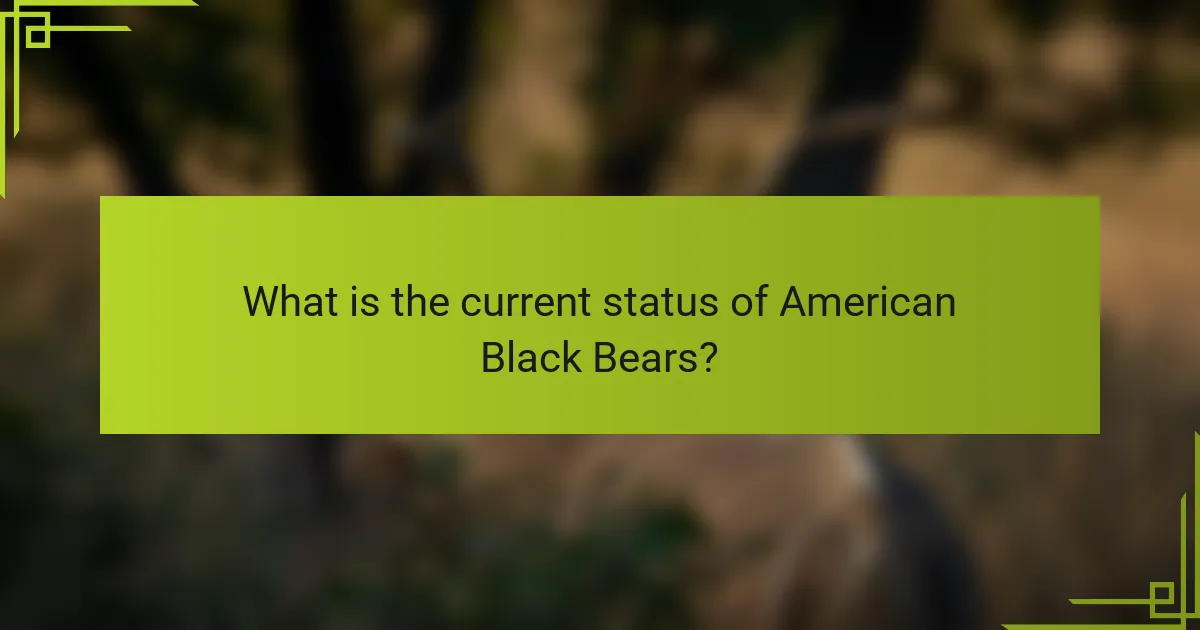American Black Bears (Ursus americanus) are currently classified as a species of least concern by the International Union for Conservation of Nature (IUCN), with stable or increasing populations estimated between 600,000 to 900,000 across North America. Effective habitat management practices, including maintaining forest health, establishing wildlife corridors, and implementing prescribed burns, have significantly contributed to their recovery. Conservation policies at both federal and state levels focus on habitat protection, regulated hunting, and community education to promote coexistence with humans. Continuous monitoring and research are essential to assess bear populations and ensure long-term conservation efforts.

What is the current status of American Black Bears?
American Black Bears are currently classified as a species of least concern by the International Union for Conservation of Nature (IUCN). Their populations are stable or increasing in many areas across North America. Habitat management practices have contributed to their recovery. Various states have implemented conservation policies to protect their habitats. Estimates suggest there are approximately 600,000 to 900,000 American Black Bears in the wild. They thrive in diverse ecosystems, including forests, swamps, and mountains. Human activities, such as urban development and hunting regulations, influence their population dynamics. Continuous monitoring and research are essential for their long-term conservation.
How is the population of American Black Bears assessed?
The population of American Black Bears is assessed through various methods, including population surveys and monitoring techniques. Researchers often use methods such as mark-recapture studies, which involve capturing bears, marking them, and releasing them to estimate population size. Additionally, biologists may employ camera traps to monitor bear activity and density in specific areas.
Genetic analysis of bear hair samples can also provide insights into population demographics and genetic diversity. States often collaborate with wildlife agencies to compile data on bear sightings and harvest reports. These assessments help inform management strategies and conservation efforts for American Black Bears across their range.
What methods are used to estimate black bear populations?
Methods used to estimate black bear populations include mark-recapture studies, genetic sampling, and population modeling. Mark-recapture involves capturing bears, marking them, and releasing them. Researchers later recapture bears to estimate population size based on the ratio of marked to unmarked individuals. Genetic sampling analyzes DNA from bear hair or scat to estimate population size and genetic diversity. Population modeling uses data on birth rates, death rates, and movement patterns to predict population trends. These methods help inform conservation efforts and management strategies for black bears.
What are the key indicators of black bear population health?
Key indicators of black bear population health include population size, reproductive rates, and mortality rates. A stable or increasing population size indicates a healthy bear population. Reproductive rates, such as the number of cubs per female, reflect the species’ ability to sustain its numbers. Low mortality rates suggest that bears are surviving to adulthood and contributing to the population. Additionally, genetic diversity is crucial for long-term viability. Healthy bears typically exhibit good body condition, which can be assessed through weight and fat reserves. Monitoring these indicators helps wildlife managers assess the overall health of black bear populations.
What factors influence the population dynamics of American Black Bears?
Population dynamics of American Black Bears are influenced by various factors including habitat availability, food resources, human interactions, and reproductive rates. Habitat loss due to urban development reduces their living space and can lead to population declines. Availability of food sources, such as berries and nuts, directly affects bear health and reproduction. Human interactions, including hunting and vehicle collisions, can significantly impact bear populations. Additionally, reproductive rates are influenced by environmental conditions and food availability, affecting population growth. Studies show that in areas with abundant food and minimal human disturbance, black bear populations thrive.
How do birth rates and mortality rates affect black bear populations?
Birth rates and mortality rates significantly influence black bear populations. Higher birth rates lead to population growth, while increased mortality rates can cause population decline. Black bears typically have a birth rate of 1 to 4 cubs per year, depending on environmental conditions and food availability. When mortality rates are low, such as during years with abundant food, more cubs survive to adulthood. Conversely, high mortality rates due to factors like habitat loss, hunting, or disease can severely reduce population numbers. For instance, studies show that in regions with high human activity, black bear populations can decline by over 50% due to increased mortality. Therefore, the balance between birth and mortality rates is crucial for maintaining stable black bear populations.
What role does habitat availability play in population dynamics?
Habitat availability significantly influences population dynamics. It affects the size and stability of animal populations. When suitable habitats are abundant, populations tend to thrive. Conversely, limited habitat can lead to overcrowding and resource depletion. This situation often results in increased competition among individuals. For example, American black bears require large territories for foraging and breeding. A study by McLoughlin et al. (2007) found that habitat fragmentation can reduce black bear populations. As habitats become scarce, bears may face higher mortality rates and lower reproductive success. This demonstrates the critical link between habitat availability and population health.

What are the habitat management strategies for American Black Bears?
Habitat management strategies for American Black Bears include maintaining forest health and connectivity. These strategies promote the availability of food sources and denning sites. Prescribed burns are used to enhance habitat diversity. Thinning overgrown forests can improve understory growth. Wildlife corridors are established to connect fragmented habitats. Monitoring bear populations helps assess habitat effectiveness. Community education programs raise awareness about bear conservation. Research indicates that these strategies enhance bear survival rates and reproductive success.
How is habitat quality evaluated for black bears?
Habitat quality for black bears is evaluated through several key indicators. These indicators include food availability, cover, and human disturbance levels. Food availability is assessed by measuring the abundance of natural food sources like berries, nuts, and vegetation. Cover is evaluated by analyzing the density and type of vegetation that provides shelter and security for bears. Human disturbance levels are measured by examining the proximity of human activities, such as roads and urban development, which can impact bear behavior and habitat use. Studies have shown that high-quality habitats support healthier bear populations and higher reproductive rates. For instance, research indicates that areas with abundant food and minimal human interference lead to increased bear density and survival rates.
What specific habitat features are essential for black bear survival?
Black bears require specific habitat features for survival. These features include dense forests with ample cover for shelter. Access to food sources such as berries, nuts, and vegetation is crucial. Water sources like rivers and lakes are necessary for hydration. Diverse habitats support foraging and breeding activities. Large territories allow for movement and resource access. Seasonal habitats are important for hibernation and food availability. Research shows that habitat fragmentation negatively impacts bear populations. Maintaining these essential features supports black bear conservation efforts.
How do seasonal changes impact black bear habitat needs?
Seasonal changes significantly impact black bear habitat needs. During spring, black bears require habitats with abundant food sources such as new foliage and flowering plants. In summer, they seek out areas with high fruit availability, including berry patches. Fall is critical for bears to find high-calorie foods to prepare for hibernation. This includes acorns and nuts from trees. Winter habitat needs shift as bears enter dens, requiring sheltered locations for hibernation. Research shows that habitat quality directly influences bear survival and reproduction rates. Studies indicate that habitat fragmentation can reduce access to these seasonal food sources, impacting bear health.
What management practices are implemented to protect bear habitats?
Management practices to protect bear habitats include habitat preservation, regulated hunting, and public education. Habitat preservation involves designating protected areas where bears can live and roam without human interference. Regulated hunting ensures that bear populations remain sustainable, preventing overhunting that could lead to habitat degradation. Public education initiatives inform communities about the importance of bear habitats and promote coexistence strategies. Additionally, monitoring bear populations helps assess habitat health and effectiveness of management practices. These practices are supported by research indicating that well-managed habitats lead to healthier bear populations.
How do controlled burns affect black bear habitats?
Controlled burns positively affect black bear habitats by promoting the growth of vegetation. These burns reduce underbrush, which can create a more open forest structure. This open environment allows sunlight to reach the forest floor, encouraging the growth of berry-producing plants. Black bears rely heavily on these berries as a food source, especially in the summer and fall.
Research indicates that areas subjected to controlled burns often see an increase in plant diversity. A study published in the Journal of Wildlife Management found that black bear populations thrived in regions with recent burns due to the abundance of forage. Controlled burns also help in maintaining healthy ecosystems, which benefits black bears and their habitats.
What is the role of wildlife corridors in habitat management?
Wildlife corridors play a crucial role in habitat management by facilitating the movement of species between fragmented habitats. These corridors help maintain genetic diversity by allowing animals to find mates across different populations. They also provide safe passage for wildlife, reducing the risks of road mortality and habitat loss. Research indicates that wildlife corridors can enhance species survival rates and promote ecosystem resilience. For instance, studies show that black bears utilize corridors to access food sources and breeding grounds, which is vital for their population stability. Overall, effective habitat management incorporates wildlife corridors to support biodiversity and ecological balance.

What conservation policies are in place for American Black Bears?
Conservation policies for American Black Bears include habitat protection, regulated hunting, and population management. These policies are implemented at federal and state levels. The U.S. Forest Service and National Park Service manage habitats critical for bear survival. Regulations limit hunting seasons and set quota systems to ensure sustainable populations. Some states have established bear sanctuaries to protect vulnerable populations. Education programs promote coexistence between bears and humans. Research initiatives monitor bear populations and health, guiding policy adjustments. These measures aim to balance conservation with human interests.
How do federal and state policies impact black bear conservation?
Federal and state policies significantly impact black bear conservation through regulations and management practices. These policies dictate hunting seasons, bag limits, and habitat protection measures. The Endangered Species Act provides federal protection for certain bear populations. State policies may include specific management plans tailored to local bear populations. Funding for conservation programs often comes from federal grants and state budgets. Collaboration between federal and state agencies enhances conservation efforts. Research indicates that effective policies lead to increased black bear populations in various regions. For example, the recovery of the American black bear in the southeastern United States is attributed to both federal protections and state management strategies.
What regulations are in place regarding hunting and trapping of black bears?
Regulations regarding hunting and trapping of black bears vary by state and region. Most states require a hunting license specifically for black bear hunting. Some jurisdictions have designated hunting seasons to protect bear populations during breeding times.
Bag limits may also be enforced, limiting the number of bears a hunter can harvest. Certain states require hunters to report their kills to monitor bear populations. Trapping regulations often include permits and restrictions on trap types to ensure humane practices.
In many areas, baiting bears for hunting is regulated or prohibited to maintain fair chase ethics. Additionally, specific areas may be designated as no-hunting zones to protect bear habitats and populations. These regulations aim to balance wildlife conservation with hunting interests.
How do conservation programs support black bear populations?
Conservation programs support black bear populations by protecting their habitats and regulating hunting. These programs establish protected areas where black bears can thrive without human interference. They also implement policies that manage hunting seasons and quotas to ensure sustainable populations.
Additionally, conservation efforts often include public education initiatives. These initiatives raise awareness about the importance of black bears in the ecosystem. They also promote coexistence strategies to reduce human-bear conflicts.
Research has shown that states with strong conservation programs have seen increases in black bear populations. For instance, the North American Bear Center reports that well-managed habitats lead to healthier bear communities.
What challenges do conservationists face in protecting American Black Bears?
Conservationists face multiple challenges in protecting American Black Bears. Habitat loss is a significant issue, driven by urban development and logging. This reduces the space available for bears to forage and reproduce. Human-bear conflicts are another challenge, often resulting from bears seeking food in residential areas. These conflicts can lead to bears being relocated or euthanized. Climate change also impacts bear habitats and food sources, disrupting their natural behaviors. Additionally, poaching remains a threat despite legal protections. Conservationists must navigate complex policies and public perceptions to effectively advocate for bear protection. These challenges require coordinated efforts and continuous education to promote coexistence.
How does urban development threaten black bear habitats?
Urban development threatens black bear habitats by fragmenting their living spaces. As cities expand, natural landscapes are altered or destroyed. This leads to a loss of food sources for black bears. Urban areas often replace forests and wetlands, which are crucial for bear survival. Roads and buildings create barriers that prevent bears from accessing essential habitats. Additionally, increased human activity can lead to bear encounters, resulting in their relocation or euthanasia. According to the U.S. Fish and Wildlife Service, habitat loss is a primary threat to black bear populations.
What are the impacts of climate change on black bear populations?
Climate change significantly impacts black bear populations. It alters their habitat, food availability, and reproductive patterns. Warmer temperatures affect the timing of food sources, such as berries and nuts. This can lead to mismatches in foraging opportunities. Reduced snow cover also impacts denning behavior and cub survival. Changes in precipitation patterns can affect the forests that provide shelter. Increased human-bear interactions may occur as bears seek food in urban areas. According to a study by the U.S. Geological Survey, climate change could lead to habitat loss for black bears. This loss may further threaten their populations and biodiversity.
What can individuals do to support American Black Bear conservation?
Individuals can support American Black Bear conservation by participating in habitat preservation efforts. This includes volunteering for local conservation organizations that focus on bear habitats. Supporting legislation that protects bear habitats is also crucial. Donations to wildlife conservation groups can provide necessary funding for bear protection initiatives. Educating others about the importance of black bears in ecosystems promotes awareness and support. Reporting illegal poaching or bear sightings to wildlife authorities helps in monitoring populations. Practicing responsible outdoor behavior, such as securing food and trash, reduces human-bear conflicts. Engaging in community programs that promote coexistence with wildlife fosters a supportive environment for black bears.
How can communities engage in habitat preservation efforts?
Communities can engage in habitat preservation efforts by implementing local conservation initiatives. These initiatives may include organizing clean-up events to remove litter from natural areas. Communities can also create awareness programs about the importance of preserving habitats. Educational workshops can teach residents about local wildlife and ecosystems. Collaborating with conservation organizations can provide resources and expertise. Establishing protected areas can help safeguard critical habitats from development. Communities can also promote sustainable land use practices to minimize habitat destruction. Engaging in citizen science projects can involve residents in monitoring local wildlife populations.
What are best practices for living in bear country?
To live safely in bear country, follow these best practices. Store food in bear-proof containers or locked vehicles. Keep garbage secured and dispose of it regularly. Avoid leaving pet food outside. Make noise while hiking to alert bears to your presence. Travel in groups, as bears are less likely to approach larger parties. Use bear spray as a deterrent if you encounter a bear. Educate yourself about bear behavior and local bear populations. Following these practices can significantly reduce the risk of bear encounters. Research indicates that proper food storage and awareness of bear presence are effective in minimizing human-bear conflicts.
The main entity of this article is the American Black Bear, a species currently classified as least concern by the IUCN, with stable or increasing populations across North America. The article provides a comprehensive overview of the population dynamics of American Black Bears, including methods for assessing their populations, key indicators of their health, and factors influencing their dynamics. It also discusses habitat management strategies, conservation policies, and the challenges faced by conservationists in protecting this species, emphasizing the importance of habitat availability, human interactions, and climate change impacts on their survival. Additionally, it outlines actions individuals and communities can take to support black bear conservation efforts.
